| Quorum regulatory RNA | |
|---|---|
 | |
| Identifiers | |
| Symbol | Qrr |
| Alt. Symbols | Qrr1–5 |
| Rfam | RF00378 |
| Other data | |
| RNA type | sRNA |
| Domain(s) | Vibrio |
| PDB structures | PDBe |
| Quorum regulatory RNA | |
|---|---|
 | |
| Identifiers | |
| Symbol | Qrr |
| Alt. Symbols | Qrr1–5 |
| Rfam | RF00378 |
| Other data | |
| RNA type | sRNA |
| Domain(s) | Vibrio |
| PDB structures | PDBe |
Qrr (Quorum regulatory RNA) [1] is a small non-coding RNA that is thought to be involved in the regulation of quorum sensing in Vibrio species. The use of small RNAs for vital functions like metabolism, infection cycling, and stress response is ubiquitous among bacteria. [2] Qrr operates as part of a negative feedback loop which regulates the shift in cell state from that of low density populations to that in high density populations. [3] This feedback system allows for rapid responses to changes in population cell density, eliminating the production of energy-costly molecules. [4] It is believed that these RNAs, guided by a protein, Hfq, can mediate the destabilization of the quorum-sensing master regulators LuxR/HapR/VanT mRNAs. [2] [5] This group of non-coding RNAs are trans-acting small RNAs (sRNAs) that bind via base pairing to the untranscribed domain of their mRNA targets. This binding results in degradation or stabilization, deciding their translational fate. [6]
There are 5 different qrr genes (Qrr1–5) in V. harveyi; of these, qrr2, 3 and 4 are activated by LuxR. [5] Other Vibrio species contain varying number of these genes, with overlapping functions and promotion. [6] Each of these Qrr RNAs are expressed at different times, fluctuating in level. [7] Each gene is expressed individually based on growth conditions, with unique factors and regulators controlling their respective expression. [6] For example, LuxT transcriptionally represses qrr1, but does not regulate the other qrr genes. [8] The genes are expressed in this order from lowest to highest: Qrr5, Qrr1, Qrr3, Qrr2, Qrr4. [8]
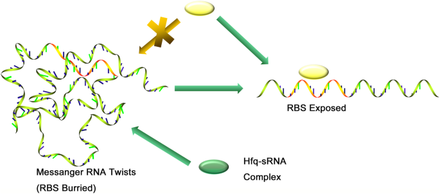
Exactly 20 mRNA targets of the RNAs have been established in Vibrio. [7] Four regulation strategies are utilized by these molecules through unique base-pairing interactions with mRNA targets: sequestration for luxO, coupled degradation for luxM, uncovering the RBS of aphA, and catalytic degradation for luxR. [7] Each Qrr RNA contains specific binding regions to differentiate between different mRNA targets. [9] Translation of AphA is enhanced for low cell density conditions, whereas LuxR is inhibited for high cell density conditions. [6] Qrr2 was found to be unique in possessing two promoters and utilized by other species in addition to Vibrio. [6] The unique type of regulation by Qrr RNA likely produces expression patterns that protein transcription factors cannot. [4]
The protein Hfq serves as a mediator between each qrr RNA and their respective mRNA targets. [7] It also protects the unstable molecules from free degradation by RNase. Abundance of Hfq limits qrr RNA binding, as the separate RNAs compete for its safeguarding behavior. [7]
Qrr RNAs were first identified in 2004 in bioinformatic screenings of several Vibrio species. [1] It is believed that the stem loop portion of the RNA structure was integral to its primordial functions, with other functionalities resulting from sequence mutations. [10] The molecule is composed of four stem loops (loops seen in "Quorum regulatory RNA" image): two stem loops operate by base-pairing to the mRNA targets, the second also insulates the structure from Rnase E-mediated degradation, the third assists in stabilizing base-pairing, and the fourth is utilized as a terminator. [4]
The qrr genes share 80% sequence similarity, with predictions of analogous secondary structures. [2] In the event of deficiency in a single Qrr RNA, the other genes are upregulated to compensate for the loss, but can also have independent functions. [2] Two known feedback loops account for the expression adjustment: HapR-Qrr and LuxO-Qrr feedback loops. [2] This functional duality give plasticity to bacteria possessing these genes, allowing them to react accordingly to environmental and communal conditions. [8]
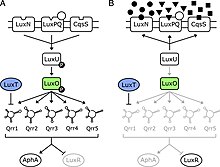
Detailed mechanistic pathways have been uncovered for how Qrr RNA is utilized in V. harveyi for the phenomenon of bioluminescence. Three autoinducers (AIs) are produced by this species: AI-1, LuxS, and CAI-1. [8] LuxN, LuxPq, and CqsS recognize these AIs, respectively. Few AIs are produced when cell density is low, which leads to a phosphorylated LuxO, along with sigma factor 54, activating qrr1-5 expression. [8] Binding sites for these two regulators are upstream of each qrr. [8] Post-transcriptionally, the Qrr RNAs promote the expression of low cell density master regulator aphA and represses expression of high cell density master regulator luxR. Their expression also inhibitors expression of the luciferase operon, which allows luminescent output for V. harveyi. [8] The opposite phenomenon occurs in high cell density, with high AI expression and subsequent reversal of aphA and luxR expression levels. The luciferase operon is expressed and luminescence occurs for cell communication. [8] The phosphorylation of LuxO is key to this mechanism, not necessarily luxO expression. [8]
Novel qrr RNAs have also been investigated recently in species outside of the Vibrio genus. One such RNA, AmiL, was identified in Pseudomonas aeruginosa. [11] AmiL was found to be involved in virulence of P. aeruginosa, including mammalian cytotoxicity, biofilm formation, and motility. [11] This RNA plays into a larger network of quorum sensing which has yet to be elucidated.
An additional 16 Qrr RNA targets outside of quorum sensing regulatory networks have been identified. [4] Among these are certain quorum-sensing-controlled virulence factors and chemotaxis receptors, thought previously to only be regulated by protein transcription factors. Since the production of these factors taxes the cell, the rapid response regulation provided by Qrr RNA could be advantageous in energy-conserving repression. [4]
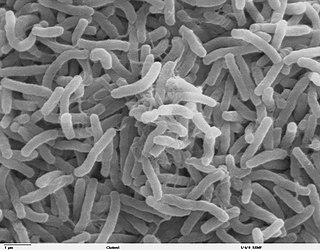
Vibrio cholerae is a species of Gram-negative, facultative anaerobe and comma-shaped bacteria. The bacteria naturally live in brackish or saltwater where they attach themselves easily to the chitin-containing shells of crabs, shrimp, and other shellfish. Some strains of V. cholerae are pathogenic to humans and cause a deadly disease called cholera, which can be derived from the consumption of undercooked or raw marine life species or drinking contaminated water.

Bonnie Lynn Bassler is an American molecular biologist; the Squibb Professor in Molecular Biology and chair of the Department of Molecular Biology at Princeton University; and a Howard Hughes Medical Institute Investigator. She has researched cell-to-cell chemical communication in bacteria and discovered key insights into the mechanism by which bacteria communicate, known as quorum sensing. She has contributed to the idea that disruption of chemical signaling can be used as an antimicrobial therapy.
In biology, quorum sensing or quorum signaling (QS) is the ability to detect and respond to cell population density by gene regulation. Quorum sensing is a type of cellular signaling, and more specifically can be considered a type of paracrine signaling. However, it also contains traits of both autocrine signaling: a cell produces both the autoinducer molecule and the receptor for the autoinducer. As one example, QS enables bacteria to restrict the expression of specific genes to the high cell densities at which the resulting phenotypes will be most beneficial, especially for phenotypes that would be ineffective at low cell densities and therefore too energetically costly to express. Many species of bacteria use quorum sensing to coordinate gene expression according to the density of their local population. In a similar fashion, some social insects use quorum sensing to determine where to nest. Quorum sensing in pathogenic bacteria activates host immune signaling and prolongs host survival, by limiting the bacterial intake of nutrients, such as tryptophan, which further is converted to serotonin. As such, quorum sensing allows a commensal interaction between host and pathogenic bacteria. Quorum sensing may also be useful for cancer cell communications.

Aliivibrio fischeri is a Gram-negative, rod-shaped bacterium found globally in marine environments. This species has bioluminescent properties, and is found predominantly in symbiosis with various marine animals, such as the Hawaiian bobtail squid. It is heterotrophic, oxidase-positive, and motile by means of a single polar flagella. Free-living A. fischeri cells survive on decaying organic matter. The bacterium is a key research organism for examination of microbial bioluminescence, quorum sensing, and bacterial-animal symbiosis. It is named after Bernhard Fischer, a German microbiologist.

Vibrio harveyi is a Gram-negative, bioluminescent, marine bacterium in the genus Vibrio. V. harveyi is rod-shaped, motile, facultatively anaerobic, halophilic, and competent for both fermentative and respiratory metabolism. It does not grow below 4 °C. V. harveyi can be found free-swimming in tropical marine waters, commensally in the gut microflora of marine animals, and as both a primary and opportunistic pathogen of marine animals, including Gorgonian corals, oysters, prawns, lobsters, the common snook, barramundi, turbot, milkfish, and seahorses. It is responsible for luminous vibriosis, a disease that affects commercially farmed penaeid prawns. Additionally, based on samples taken by ocean-going ships, V. harveyi is thought to be the cause of the milky seas effect, in which, during the night, a uniform blue glow is emitted from the seawater. Some glows can cover nearly 6,000 sq mi (16,000 km2).

N-Acyl homoserine lactones are a class of signaling molecules involved in bacterial quorum sensing, a means of communication between bacteria enabling behaviors based on population density.

The MicA RNA is a small non-coding RNA that was discovered in E. coli during a large scale screen. Expression of SraD is highly abundant in stationary phase, but low levels could be detected in exponentially growing cells as well.

In molecular biology the ArcZ RNA is a small non-coding RNA (ncRNA). It is the functional product of a gene which is not translated into protein. ArcZ is an Hfq binding RNA that functions as an antisense regulator of a number of protein coding genes.
Autoinducers are signaling molecules that are produced in response to changes in cell-population density. As the density of quorum sensing bacterial cells increases so does the concentration of the autoinducer. Detection of signal molecules by bacteria acts as stimulation which leads to altered gene expression once the minimal threshold is reached. Quorum sensing is a phenomenon that allows both Gram-negative and Gram-positive bacteria to sense one another and to regulate a wide variety of physiological activities. Such activities include symbiosis, virulence, motility, antibiotic production, and biofilm formation. Autoinducers come in a number of different forms depending on the species, but the effect that they have is similar in many cases. Autoinducers allow bacteria to communicate both within and between different species. This communication alters gene expression and allows bacteria to mount coordinated responses to their environments, in a manner that is comparable to behavior and signaling in higher organisms. Not surprisingly, it has been suggested that quorum sensing may have been an important evolutionary milestone that ultimately gave rise to multicellular life forms.

Autoinducer-2 (AI-2), a furanosyl borate diester or tetrahydroxy furan, is a member of a family of signaling molecules used in quorum sensing. AI-2 is one of only a few known biomolecules incorporating boron. First identified in the marine bacterium Vibrio harveyi, AI-2 is produced and recognized by many Gram-negative and Gram-positive bacteria. AI-2 arises by the reaction of 4,5-dihydroxy-2,3-pentanedione, which is produced enzymatically, with boric acid and is recognized by the two-component sensor kinase LuxPQ in Vibrionaceae.

An Hfq binding sRNA is an sRNA that binds the bacterial RNA binding protein called Hfq. A number of bacterial small RNAs which have been shown to bind to Hfq have been characterised . Many of these RNAs share a similar structure composed of three stem-loops. Several studies have expanded this list, and experimentally validated a total of 64 Hfq binding sRNA in Salmonella Typhimurium. A transcriptome wide study on Hfq binding sites in Salmonella mapped 126 Hfq binding sites within sRNAs. Genomic SELEX has been used to show that Hfq binding RNAs are enriched in the sequence motif 5′-AAYAAYAA-3′. Genome-wide study identified 40 candidate Hfq-dependent sRNAs in plant pathogen Erwinia amylovora. 12 of them were confirmed by Northern blot.

The rsmX gene is part of the Rsm/Csr family of non-coding RNAs (ncRNAs). Members of the Rsm/Csr family are present in a diverse range of bacteria, including Escherichia coli, Erwinia, Salmonella, Vibrio and Pseudomonas. These ncRNAs act by sequestering translational repressor proteins, called RsmA, activating expression of downstream genes that would normally be blocked by the repressors. Sequestering of target proteins is dependent upon exposed GGA motifs in the stem loops of the ncRNAs. Typically, the activated genes are involved in secondary metabolism, biofilm formation and motility.
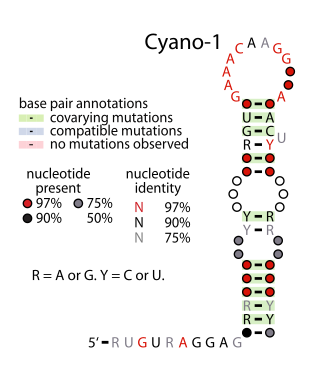
Yfr2 is a family of non-coding RNAs. Members of the Yrf2 family have been identified in almost all studied species of cyanobacteria. The family was identified through a bioinformatics screen of published cyanobacterial genomes, having previously been grouped in a family of Yfr2–5.

MicX sRNA is a small non-coding RNA found in Vibrio cholerae. It was given the name MicX as it has a similar function to MicA, MicC and MicF in E. coli. MicX sRNA negatively regulates an outer membrane protein and also a component of an ABC transporter. These interactions were predicted and then confirmed using a DNA microarray.
Bacterial small RNAs (bsRNA) are small RNAs produced by bacteria; they are 50- to 500-nucleotide non-coding RNA molecules, highly structured and containing several stem-loops. Numerous sRNAs have been identified using both computational analysis and laboratory-based techniques such as Northern blotting, microarrays and RNA-Seq in a number of bacterial species including Escherichia coli, the model pathogen Salmonella, the nitrogen-fixing alphaproteobacterium Sinorhizobium meliloti, marine cyanobacteria, Francisella tularensis, Streptococcus pyogenes, the pathogen Staphylococcus aureus, and the plant pathogen Xanthomonas oryzae pathovar oryzae. Bacterial sRNAs affect how genes are expressed within bacterial cells via interaction with mRNA or protein, and thus can affect a variety of bacterial functions like metabolism, virulence, environmental stress response, and structure.
Interspecies quorum sensing is a type of quorum sensing in which bacteria send and receive signals to other species besides their own. This is accomplished by the secretion of signaling molecules which trigger a response in nearby bacteria at high enough concentrations. Once the molecule hits a certain concentration it triggers the transcription of certain genes such as virulence factors. It has been discovered that bacteria can not only interact via quorum sensing with members of their own species but that there is a kind of universal molecule that allows them to gather information about other species as well. This universal molecule is called autoinducer 2 or AI-2.
In molecular biology, Vibrio cholerae ToxT activated RNAs are small RNAs which are produced by the bacterium Vibrio cholerae. They are regulated by the transcriptional activator ToxT and may play a role in V. cholerae virulence. Two ToxT activated RNAs have been described: TarA and TarB.

Bioluminescent bacteria are light-producing bacteria that are predominantly present in sea water, marine sediments, the surface of decomposing fish and in the gut of marine animals. While not as common, bacterial bioluminescence is also found in terrestrial and freshwater bacteria. These bacteria may be free living or in symbiosis with animals such as the Hawaiian Bobtail squid or terrestrial nematodes. The host organisms provide these bacteria a safe home and sufficient nutrition. In exchange, the hosts use the light produced by the bacteria for camouflage, prey and/or mate attraction. Bioluminescent bacteria have evolved symbiotic relationships with other organisms in which both participants benefit close to equally. Another possible reason bacteria use luminescence reaction is for quorum sensing, an ability to regulate gene expression in response to bacterial cell density.
Everett Peter Greenberg is an American microbiologist. He is the inaugural Eugene and Martha Nester Professor of Microbiology at the Department of Microbiology of the University of Washington School of Medicine. He is best known for his research on quorum sensing, and has received multiple awards for his work.
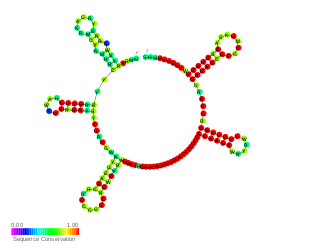
VqmR small RNA was discovered in Vibrio cholerae, a bacterium which can cause cholera, using differential RNA sequencing (sRNA-seq) under conditions of low and high cell density which were being used to study quorum sensing (QS). QS controls virulence and biofilm formation in Vibrio cholerae; it has been shown previously that it is directed by the Qrr sRNAs. VqmR has been shown to repress the expression of multiple mRNAs including the rtx toxin genes and the vpsT, which is required for biofilm formation. In fact, VqmR which is highly conserved in vibrionaceae, was shown to strongly inhibit biofilm formation by repressing the vpsT gene; it could be the link between biofilm formation and QS.